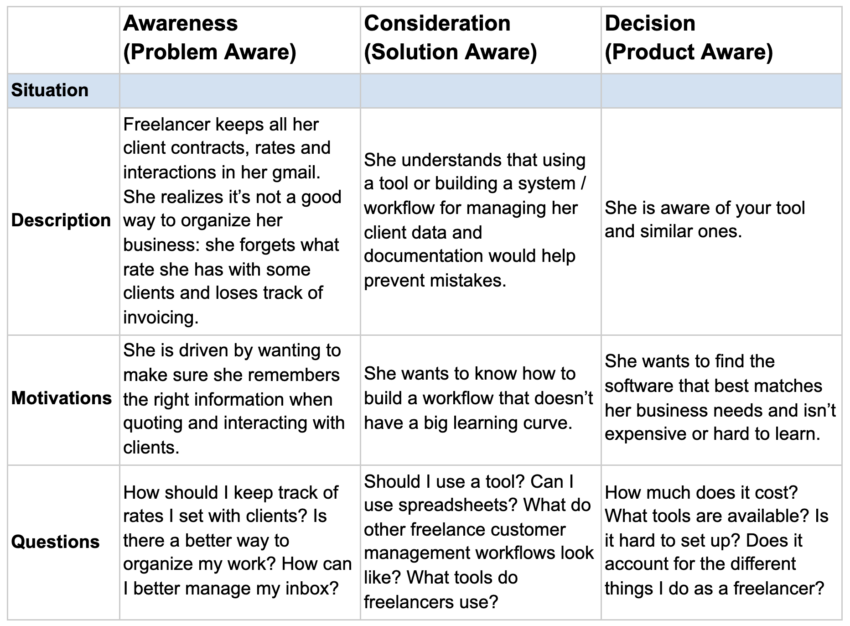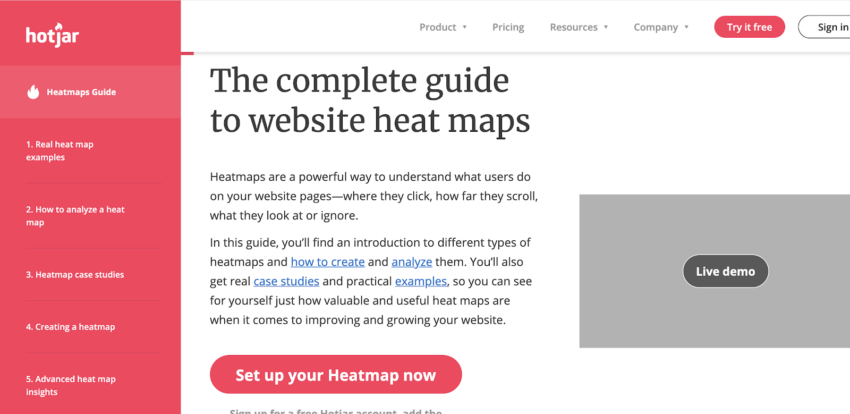Content Marketing: The First 4 Content Articles You Should Write
If you’re here, you’ve already established that content marketing and SEO are channels you want to pursue.
But, you’re most likely overwhelmed by calls with investors, leads, or you simply can’t get away from product development to put the time into a strategy like you’d want to.
If you’re here, it’s probably because you believe (like me) that content for content’s sake won’t cut it. And you want to do things strategically, or not at all.
In this article, I’ll walk you through the four articles you should write first to move the needle in your business. After reading, you should also have a clear path forward for continuing content thereafter.
Ironically, most of the top-ranking articles on Google about what content to create or how to plan your content strategy don’t offer much more than some generic advice:
- Do customer research (I’m going to tell you to do this too, but I’ll explain why, how, and how to use that information in your content).
- Create a content calendar.
- Share and distribute your content.
If this information isn’t painfully obvious to you, I hope that this article will help you feel better equipped to know exactly what to write for your first four blog articles and beyond.
First, some basics. I promise not to get overly generic, but since you haven’t started your content strategy yet, we need to lay down the foundations first.
What a content strategy should look like
A content strategy is more than just jotting down your “why” next to your customer avatar and stapling it to a list of blog post topics.
At my content marketing agency, the strategies we create for our clients are built out into four phases:
- Research (getting to know the customers, their journeys, their pains, and doing keyword research for SEO; then mapping out the strategy and execution calendar)
- Content creation
- Content promotion (through online communities & paid distribution)
- Analysis and re-optimization
What content will move the needle?
Ideally, you’ll already have a customer journey mapped out. It doesn’t need to be complicated.
You don’t need heatmaps or professionally designed flowcharts to do this. But you do need to understand what questions your customers ask as they gain more information about their problem and your solution.
You can start with a simple table. Let’s say you have a tool that offers an accounting and CRM platform for freelancers.

A content strategy should fill these three columns (starting from the decision phase), and account for a few other things. If you have different avatars, I recommend going through this process for each one.
Try to be exhaustive in the questions people have in each phase. Then, categorize the answers by topic.
You’ll want to have categories for:
- Brand & culture – your why, your mission, what makes you stand out
- Use case guides– usually, each use case can get its own category that you fill out with content from each growth stage listed above.
- Comparisons and product – comparing your product with others, posts about features or your kind of tool
- TOFU guides – all the other stuff that interests your customers and is related to your product.
The list of topics within the use case guides will be the most robust. Hotjar is a great example of this in action. They have several use cases: CRO, UX, customer journey mapping, and more. So they create entire guides around each:

This is what we call a topic cluster in the content marketing world, the cluster being around the category “website heat maps,” and each sub-topic on the left-hand menu is a new blog post.
Okay, so where do you actually start, though?
Working from the bottom of the funnel up
Bottom-of-the-funnel, or BOFU, content is content for people who are ready to buy.
You can usually identify this kind of content with keywords like:
- X vs Y
- Cost of X
- Best X tools
- Best X software
- Buy X
A lot of marketers don’t like to start with this kind of content because it often has low traffic volume.
It’s true, this kind of content doesn’t have a very high monthly volume. Especially compared to top of the funnel topics like “how to manage time,” but the traffic is better quality, in the sense that it brings more dinero or has a higher conversion potential.
A good content strategy has a bit of a mix: you don’t want to only write “buy me, buy me” posts if you’re building a brand. But you need to include these in at least half of the content you create at the start.
Based on what I’ve seen from some very opinionated LinkedIn influencers, I’ve observed three schools of thought in content marketing:
- The best content gets the most traffic.
- The best content gets the most conversions.
- Stop trying to track and attribute your content; word of mouth and brand can’t be tracked!
I personally don’t see why we need to choose one over the other. I think they’re all right, and all angles need to be considered in your content strategy. Just like a good content strategy is a mix of technical, on-page, and off-page optimization, it should also be a good combo of traffic, conversions, and brand-building.
However, we need to start with a focus on conversions. Why? Because content has a compounding effect, so you want to get the money-making content out into the world to start compounding first. Then you don’t have to wait as long for conversions.
It doesn’t mean that traffic, brand, and word-of-mouth don’t matter—they all do. But your first posts should have a higher concentration of BOFU posts.
What are the first four posts you should write about on your blog?
I can’t spoon-feed you the first 4 titles you need to write since it’s context-dependent, but I can give you some guidance on what I usually like to start my clients’ blogs with:
- A product or comparison piece
- A case study or a feature story
- Your brand’s unique angle
- A pain point piece
Let me break down what these would contain:
Your product or comparison piece
Ideally, there will be many of these. You should exhaust the BOFU pieces as quickly as you can without harming the user experience. This is where you’ll write about the top X tools (yours being one of them) or comparing your tool with your competitors.
You’re probably thinking, won’t these articles seem biased since I’m the one writing them?
As long as you’re clear about your USP, don’t trash talk the other tools, and you’re honest about who your tool is for, there’s no reason not to write these posts. They have the highest conversion—the people who read these posts are ready to buy.
You don’t need to walk them through the customer journey; you don’t need to explain why there’s value in using a tool or service like yours—they’ve already been through all of that. They just want a bit of final guidance on which tool or service to pick.
Plus, other people (including your competitors) are going to be ranking for these keywords. There’s no reason you shouldn’t be ranking for keywords about your brand.
Your customers are smart; they can see that you’re the one who wrote the post. And most of the time, they’re overwhelmed with choice and don’t know why one tool or service is better for them than another. You’re just helping by telling them, “this is why we’re different; this is who we’re for.”
A case study or a feature story
Case studies are one of the best ways to use storytelling while driving conversions.
These are also BOFU pieces and help paint a picture to your prospects of their business or life if only they worked with you.
But instead of focusing it on your product or service, focus the piece on the story. Who’s it about? What was their challenge? What did you achieve together? How did you do it?
If you’re so early in your business that you don’t yet have a success story to write a case study about, then I still recommend you write feature stories. This can be an example of how another company (that suits your ICP) could use your product or service. Still, showcase them more than you.
Here’s an example of a case study I wrote for one of our clients. You see their story, the challenges, and how we helped them. What’s special about it is that it’s not a typical marketing case study that’s only about me and my service. I tell a story, I share the solutions we use. I’m arming the reader with an opportunity to do it themselves. But I also show them what we can do for them.
Your brand’s unique angle
This is where you show yourself as a brand: your unique angle, your strong opinion, your contribution to the world, whatever that may be.
Plausible Analytics, for example, wrote a piece titled “Why you should stop using Google Analytics on your website.” It was an opinionated, controversial, and well-researched piece (that also placed them as a great alternative to GA). It made the front page of Hacker News in April and broke records for the most sign-ups in the company’s history.
I think this piece is amazing because not only does it challenge old conventions (old in website designers, advertisers, and marketers’ terms), but it explains precisely why and then presents itself as a viable alternative. It’s a BOFU piece elegantly dressed as an opinion piece, and it’s marvelous.
As a relatively new startup with only 50 beta users in March, after publishing the opinion piece, they hit 272 signups the next month, according to their April 2020 recap.
A pain point piece
You’ll be familiar with your avatar’s pain points from your customer research and journey mapping stage. I recommend choosing a pain point in the mid or bottom part of the funnel. This is where you help your customer solve a pain point they have that’s related to your product or service.
This piece should be closely tied to SEO keywords and well optimized for search. Ideally, all your pieces are SEO-optimized, but that’s not always possible (it becomes most difficult for the thought leadership/opinion pieces).
This is where you tell your customer with your content, “I really understand what you’re going through, and here’s a solution.”
You’ll need a clear understanding of their daily pains for this to work: telling an SDR “want to make more sales?” won’t work. Everyone wants more sales. The resonance with their pain point needs to be more specific, like “what’s a benchmark for demo no-shows, and how can you improve it?”
Solve this ONE specific problem for them in this piece.
Moving forward after your first four pieces
After these first four pieces, use your content strategy to guide the next pieces.
Exhaust all the possible BOFU pieces before moving onto any TOFU (top of the funnel) pieces.
Mixing it up with thought leadership, pain point SEO pieces, and feature stories will help keep your content interesting and grabbing people’s interest as you scale your content. Here’s the key takeaway: your content marketing strategy should fill every part of the funnel for all of your avatars, starting from the bottom up. That should keep you busy for a while!
